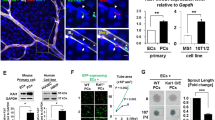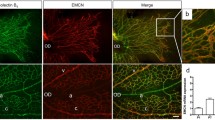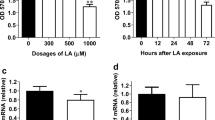Abstract
Angiogenesis plays a critical role in many physiological and pathological phenomena. A number of anti-angiogenesis drugs have been used in the clinical treatment of diseases such as malignant tumors and macular degeneration. Vascular endothelial growth factor (VEGF), the major pro-angiogenesis factor, is known to stimulate various steps of endothelial angiogenic activity, such as proliferation, migration, and differentiation into vessel-like tubes. In this study, we tested the effects of bp5250 on the angiogenesis of human umbilical endothelial cells (HUVECs). Bp5250 suppressed VEGF-induced endothelial cell proliferation by triggering apoptosis, and reduced endothelial cell migration toward VEGF. Bp5250 also decreased VEGF-stimulated tube formation and rat aortic ring sprouting on Matrigel in a concentration-dependent manner. In the VEGF-activated signaling pathways, bp5250 decreased the phosphorylation of ERK, p38, PI3K-AKT, Src, and FAK and also reduced the activation of the cytoskeleton-associated Rho family, all in a concentration-dependent manner. Bp5250 also attenuated the hypoxia-inducible factor-1α (HIF-1α) and VEGF-stimulated mRNA expression of HUVECs under the hypoxic condition. In vivo, angiogenesis was restrained by a daily intraperitoneal administration of bp5250 in a dose-dependent manner (1–3 mg/kg/d) in the Matrigel plug implantation assay. These results indicate that bp5250 is a potential candidate for developing anti-angiogenic agents.






Similar content being viewed by others

References
Abedi H, Zachary I (1997) Vascular endothelial growth factor stimulates tyrosine phosphorylation and recruitment to new focal adhesions of focal adhesion kinase and paxillin in endothelial cells. J Biol Chem 272(24):15442–15451
Aebersold DM, Burri P, Beer KT, Laissue J, Djonov V, Greiner RH et al (2001) Expression of hypoxia-inducible factor-1alpha: a novel predictive and prognostic parameter in the radiotherapy of oropharyngeal cancer. Cancer Res 61(7):2911–2916
Bertout JA, Patel SA, Simon MC (2008) The impact of O2 availability on human cancer. Nat Rev Cancer 8(12):967–975
Bondavalli F, Bruno O, Ranise A, Schenone P, Losasso C, Stella L et al (1990) 3,5-Diphenyl-1H-pyrazole derivatives. VI—Esters and 2-dialkylaminoethyl ethers of 1(2-hydroxy-2-phenylethyl)-3,5-diphenyl-1H-pyrazole and N, N-disubstituted 1-(2-amino-2-phenylethyl)-3,5-diphenyl-1H-pyrazoles with depressant and platelet antiaggregating activities. Farmaco 45(5):511–526
Bryan BA, D'Amore PA (2007) What tangled webs they weave: Rho-GTPase control of angiogenesis. Cell Mol Life Sci 64(16):2053–2065
Carden CP, Larkin JM, Rosenthal MA (2008) What is the risk of intracranial bleeding during anti-VEGF therapy? Neuro Oncol 10(4):624–630
Carmeliet P, Jain RK (2000) Angiogenesis in cancer and other diseases. Nature 407(6801):249–257
Chung AS, Lee J, Ferrara N (2010) Targeting the tumour vasculature: insights from physiological angiogenesis. Nat Rev Cancer 10(7):505–514
Cook KM, Figg WD (2010) Angiogenesis inhibitors: current strategies and future prospects. CA Cancer J Clin 60(4):222–243
Davis GE, Bayless KJ, Mavila A (2002) Molecular basis of endothelial cell morphogenesis in three-dimensional extracellular matrices. Anat Rec 268(3):252–275
Dayan F, Mazure NM, Brahimi-Horn MC, Pouyssegur J (2008) A dialogue between the hypoxia-inducible factor and the tumor microenvironment. Cancer Microenviron 1(1):53–68
Fang J, Zhou Q, Liu LZ, Xia C, Hu X, Shi X et al (2007) Apigenin inhibits tumor angiogenesis through decreasing HIF-1alpha and VEGF expression. Carcinogenesis 28(4):858–864
Farag AM, Mayhoub AS, Barakat SE, Bayomi AH (2008) Regioselective synthesis and antitumor screening of some novel N-phenylpyrazole derivatives. Bioorg Med Chem 16(2):881–889
Folkman J (1971) Tumor angiogenesis: therapeutic implications. N Engl J Med 285(21):1182–1186
Folkman J (1995) Clinical applications of research on angiogenesis. N Engl J Med 333(26):1757–1763
Folkman J (2007) Angiogenesis: an organizing principle for drug discovery? Nat Rev Drug Discov 6(4):273–286
Gay LJ, Felding-Habermann B (2011) Contribution of platelets to tumour metastasis. Nat Rev Cancer 11(2):123–134
Genin MJ, Biles C, Keiser BJ, Poppe SM, Swaney SM, Tarpley WG et al (2000) Novel 1,5-diphenylpyrazole nonnucleoside HIV-1 reverse transcriptase inhibitors with enhanced activity versus the delavirdine-resistant P236L mutant: lead identification and SAR of 3- and 4-substituted derivatives. J Med Chem 43(5):1034–1040
Gordon MS, Cunningham D (2005) Managing patients treated with bevacizumab combination therapy. Oncology 69[Suppl 3]:25–33
Hanahan D, Folkman J (1996) Patterns and emerging mechanisms of the angiogenic switch during tumorigenesis. Cell 86(3):353–364
Hiraga T, Kizaka-Kondoh S, Hirota K, Hiraoka M, Yoneda T (2007) Hypoxia and hypoxia-inducible factor-1 expression enhance osteolytic bone metastases of breast cancer. Cancer Res 67(9):4157–4163
Huang YT, Pan SL, Guh JH, Chang YL, Lee FY, Kuo SC et al (2005) YC-1 suppresses constitutive nuclear factor-kappaB activation and induces apoptosis in human prostate cancer cells. Mol Cancer Ther 4(10):1628–1635
Huang C, Li J, Song L, Zhang D, Tong Q, Ding M et al (2006) Black raspberry extracts inhibit benzo(a)pyrene diol-epoxide-induced activator protein 1 activation and VEGF transcription by targeting the phosphotidylinositol 3-kinase/Akt pathway. Cancer Res 66(1):581–587
Jaffe AB, Hall A (2005) Rho GTPases: biochemistry and biology. Annu Rev Cell Dev Biol 21:247–269
Jaffe EA, Nachman RL, Becker CG, Minick CR (1973) Culture of human endothelial cells derived from umbilical veins. Identification by morphologic and immunologic criteria. J Clin Invest 52(11):2745–2756
Jain S, Harris J, Ware J (2010) Platelets: linking hemostasis and cancer. Arterioscler Thromb Vasc Biol 30(12):2362–2367
Jiang BH, Liu LZ (2008) AKT signaling in regulating angiogenesis. Curr Cancer Drug Targets 8(1):19–26
Kubota Y, Kleinman HK, Martin GR, Lawley TJ (1988) Role of laminin and basement membrane in the morphological differentiation of human endothelial cells into capillary-like structures. J Cell Biol 107(4):1589–1598
Leavesley DI, Schwartz MA, Rosenfeld M, Cheresh DA (1993) Integrin beta 1- and beta 3-mediated endothelial cell migration is triggered through distinct signaling mechanisms. J Cell Biol 121(1):163–170
Leighl NB, Bennouna J, Yi J, Moore N, Hambleton J, Hurwitz H (2011) Bleeding events in bevacizumab-treated cancer patients who received full-dose anticoagulation and remained on study. Br J Cancer 104(3):413–418
Li SH, Shin DH, Chun YS, Lee MK, Kim MS, Park JW (2008) A novel mode of action of YC-1 in HIF inhibition: stimulation of FIH-dependent p300 dissociation from HIF-1{alpha}. Mol Cancer Ther 7(12):3729–3738
Liu YN, Pan SL, Peng CY, Guh JH, Huang DM, Chang YL et al (2006) YC-1 [3-(5'-hydroxymethyl-2'-furyl)-1-benzyl indazole] inhibits neointima formation in balloon-injured rat carotid through suppression of expressions and activities of matrix metalloproteinases 2 and 9. J Pharmacol Exp Ther 316(1):35–41
Mirshahi P, Toprak SK, Faussat AM, Dubrulle S, Marie JP, Soria C et al (2006) Malignant hematopoietic cells induce an increased expression of VEGFR-1 and VEGFR-3 on bone marrow endothelial cells via AKT and mTOR signalling pathways. Biochem Biophys Res Commun 349(3):1003–1010
Munoz-Chapuli R, Quesada AR, Angel Medina M (2004) Angiogenesis and signal transduction in endothelial cells. Cell Mol Life Sci 61(17):2224–2243
Nicosia RF, Ottinetti A (1990) Modulation of microvascular growth and morphogenesis by reconstituted basement membrane gel in three-dimensional cultures of rat aorta: a comparative study of angiogenesis in matrigel, collagen, fibrin, and plasma clot. Vitro Cell Dev Biol 26(2):119–128
Pan SL, Guh JH, Peng CY, Wang SW, Chang YL, Cheng FC et al (2005) YC-1 [3-(5'-hydroxymethyl-2'-furyl)-1-benzyl indazole] inhibits endothelial cell functions induced by angiogenic factors in vitro and angiogenesis in vivo models. J Pharmacol Exp Ther 314(1):35–42
Pouessel D, Culine S (2008) High frequency of intracerebral hemorrhage in metastatic renal carcinoma patients with brain metastases treated with tyrosine kinase inhibitors targeting the vascular endothelial growth factor receptor. Eur Urol 53(2):376–381
Pugh CW, Ratcliffe PJ (2003) Regulation of angiogenesis by hypoxia: role of the HIF system. Nat Med 9(6):677–684
Raftopoulou M, Hall A (2004) Cell migration: Rho GTPases lead the way. Dev Biol 265(1):23–32
Ranpura V, Hapani S, Wu S (2011) Treatment-related mortality with bevacizumab in cancer patients: a meta-analysis. JAMA 305(5):487–494
Rousseau S, Houle F, Landry J, Huot J (1997) p38 MAP kinase activation by vascular endothelial growth factor mediates actin reorganization and cell migration in human endothelial cells. Oncogene 15(18):2169–2177
Scappaticci FA, Skillings JR, Holden SN, Gerber HP, Miller K, Kabbinavar F et al (2007) Arterial thromboembolic events in patients with metastatic carcinoma treated with chemotherapy and bevacizumab. J Natl Cancer Inst 99(16):1232–1239
Sebolt-Leopold JS, Herrera R (2004) Targeting the mitogen-activated protein kinase cascade to treat cancer. Nat Rev Cancer 4(12):937–947
Skuli N, Liu L, Runge A, Wang T, Yuan L, Patel S et al (2009) Endothelial deletion of hypoxia-inducible factor-2alpha (HIF-2alpha) alters vascular function and tumor angiogenesis. Blood 114(2):469–477
Tang N, Wang L, Esko J, Giordano FJ, Huang Y, Gerber HP et al (2004) Loss of HIF-1alpha in endothelial cells disrupts a hypoxia-driven VEGF autocrine loop necessary for tumorigenesis. Cancer Cell 6(5):485–495
Wu CC, Ko FN, Kuo SC, Lee FY, Teng CM (1995) YC-1 inhibited human platelet aggregation through NO-independent activation of soluble guanylate cyclase. Br J Pharmacol 116(3):1973–1978
Yeh WL, Lu DY, Lin CJ, Liou HC, Fu WM (2007) Inhibition of hypoxia-induced increase of blood-brain barrier permeability by YC-1 through the antagonism of HIF-1alpha accumulation and VEGF expression. Mol Pharmacol 72(2):440–449
Acknowledgments
This work was supported by grants from the National Science Council (NSC97-2323-B-002-008, NSC98-2323-B-002-009, NSC99-2323-B-002-004 and NSC99-2320-B-039-010-MY3) of Taiwan.
Conflict of interest
The authors state that there is no conflict of interest.
Author information
Authors and Affiliations
Corresponding authors
Rights and permissions
About this article
Cite this article
Lin, KT., Lien, JC., Chung, CH. et al. Bp5250 inhibits vascular endothelial growth factor-induced angiogenesis and HIF-1α expression on endothelial cells. Naunyn-Schmiedeberg's Arch Pharmacol 385, 39–49 (2012). https://doi.org/10.1007/s00210-011-0690-2
Received:
Accepted:
Published:
Issue Date:
DOI: https://doi.org/10.1007/s00210-011-0690-2



